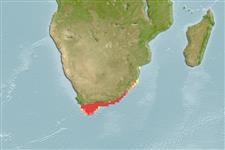Malacostraca |
Decapoda |
Scyllaridae
Environment: milieu / climate zone / depth range / distribution range
Ecology
Benthic; depth range 37 - 380 m (Ref. 4), usually 37 - 100 m (Ref. 4). Subtropical; 23°S - 37°S, 19°E - 38°E (Ref. 4)
Indo-West Pacific and Southeast Atlantic: Mozambique and South Africa.
Length at first maturity / Size / Weight / Age
Maturity: Lm ? range ? - ? cm Max length : 20.0 cm TL male/unsexed; (Ref. 4)
It has lengths of 20 cm, maximum total body length; 9 cm, carapace length (Ref. 4). Occurs at a depth range from 37 to 380 m (mostly less than 100 m) on a substrate of fine sediments, mud or fine sand. The animals seem to dig into the mud (Ref. 4).
Life cycle and mating behavior
Maturity | Reproduction | Spawning | Eggs | Fecundity | Larvae
Members of the order Decapoda are mostly gonochoric. Mating behavior: Precopulatory courtship ritual is common (through olfactory and tactile cues); usually indirect sperm transfer.
Holthuis, L.B. 1991 FAO Species Catalogue. Vol. 13. Marine lobsters of the world. An annotated and illustrated catalogue of species of interest to fisheries known to date. FAO Fish. Synop. 125(13):292p. Rome: FAO. (Ref. 4)
IUCN Red List Status
(Ref. 130435: Version 2025-1)
CITES status (Ref. 108899)
Not Evaluated
Not Evaluated
Threat to humans
Human uses
Fisheries: minor commercial
| FishSource |
Tools
More information
Trophic EcologyFood items (preys)Diet compositionFood consumptionPredators Population dynamicsGrowth
Max. ages / sizes
Length-weight rel.
Length-length rel.
Length-frequencies
Mass conversion
Abundance
Life cycleReproductionMaturityFecunditySpawningEggsEgg developmentLarvae PhysiologyOxygen consumption
Human RelatedStamps, coins, misc.
Internet sources
Estimates based on models
Preferred temperature
(Ref.
115969): 12.8 - 23.3, mean 16.5 (based on 20 cells).
Fishing Vulnerability
Low vulnerability (10 of 100).
